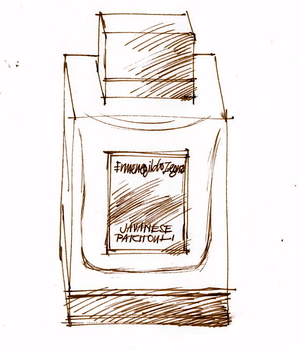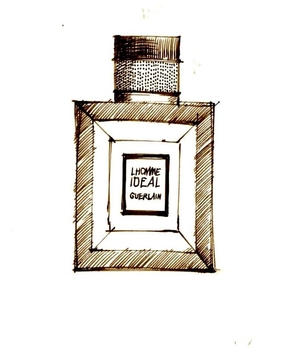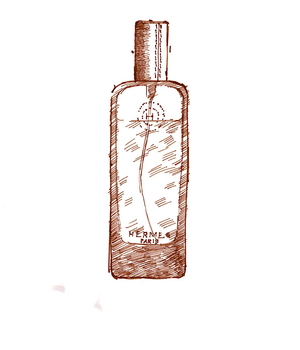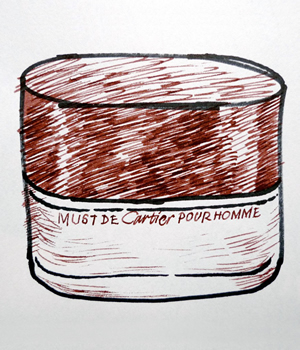Tagged With ‘“tonka bean”’
Ermenegildo Zegna
Javanese Patchouli
4 July, 2015

Patchouli – a tropical plant in the mint family – has been used as a perfume for centuries. The story goes that it was introduced to the West by Chinese and Indian traders, who used its leaves in bundles of silk as a moth repellent. The perfume oil is extracted from the leaves of several closely related species belonging to the Pogostemon family, which are grown commercially across Asia and West Africa.
For many people the scent remains indelibly associated with the hippy era, when miasmatic waves of cheap patchouli oil belched forth from bong shops and student campuses across the Western world.
But while there’s still cheap patchouli around (try visiting Camden Market over a sweaty weekend), the highest quality oils have a completely different character. Light rather than heavy, fresh rather than sweaty, top-notch patchouli is a refined, delicious fragrance, working equally well on its own or in combination with other perfume ingredients – which is why it’s so widely used in perfumery still.
There aren’t, though, that many really classy men’s perfumes in which patchouli is the dominant scent – I guess because perfume companies feel that those unfortunate hippy associations are still too strong. Givenchy Gentleman used to be a fine men’s example, but sadly it has been reformulated in recent years and isn’t a patch on its previous incarnation, so it’s been great to discover Javanese Patchouli, from the smart Italian business-suit brand Ermenegildo Zegna.
Javanese Patchouli is one of six ‘premium’ perfumes in Zegna’s ‘Essenze’ collection, which was launched in 2012. Each of the perfumes is built around a single scent, sourced from a single country or region: apart from Javanese Patchouli there’s Haitian Vetiver, Italian Bergamot, Indonesian Oud, Sicilian Mandarin and Florentine Iris.
Each 125ml bottle in the Essenze range currently (in mid-2014) costs £140, so they’re certainly not cheap; by comparison a 100ml bottle of Zegna’s Uomo scent costs £60, less than half as much. But – and I hope by now I don’t automatically associate quality with price – the two I’ve tried so far do feel luxurious and refined.
Javanese Patchouli smells, to me, like nothing else, in the sense that all I smell is patchouli, of the highest quality. Given that it’s such a lovely, gentle smell that’s absolutely fine with me, though apparently its ingredients also include soft, faintly chocolatey tonka bean, cedar wood, bergamot and pink pepper. I can’t smell any of those, but perhaps my nose is simply not sensitive enough; if they help make this perfume smell as good as it does, though, I’m perfectly happy that they’re there. I only wish I knew who the perfumer was so I could congratulate her or him.
The bottle (which after all is part of what you’re buying) is well made too, in heavy glass with a black magnetic cap that clonks satisfyingly in place, like the door of an expensive limousine. It’s not, perhaps, quite as sophisticated a design as comparable ‘premium’ perfumes from Dior or Chanel, but at least it’s not hideous or tacky, which all too many contemporary perfume bottles are. And the box it comes in conceals some rather clever cardboard technology, which locks the bottle snugly into place in an oddly pleasing way.
My only criticism, I suppose, is that I can’t smell it on my skin for very long. I was going to say that’s a bit of a swizz, since for £140 you’d hope to get something that didn’t disappear so fast, but I’m told that other people can smell it hours after I can, so at least someone else will get the benefit of your investment.
Guerlain
L’Homme Idéal
11 October, 2014
 I have before me a bottle of Amaretto liqueur, which I’m tempted to drink, though seeing as it’s ten in the morning I probably shouldn’t. I also have a bottle of the latest men’s perfume from Guerlain, L’Homme Idéal, which you’ll be relieved to hear I won’t be drinking either.
I have before me a bottle of Amaretto liqueur, which I’m tempted to drink, though seeing as it’s ten in the morning I probably shouldn’t. I also have a bottle of the latest men’s perfume from Guerlain, L’Homme Idéal, which you’ll be relieved to hear I won’t be drinking either.
The reason for this conjunction is that several reviews of L’Homme Idéal have suggested that it smells distinctly like Amaretto, so I’m testing whether they do – and the answer is that, side by side like this, they don’t. Amaretto smells far sweeter and more almondy, with a touch of bitter almonds that L’Homme Idéal lacks.
All the same, the Amaretto comparison should give you some idea of L’Homme Idéal’s character: burnt-sugar sweet and, yes, really quite almondy. It’s a smell that won’t appeal to every man (though I suspect a lot of women will like it), and in fact the perfume hasn’t exactly been greeted with universal acclaim, though personally I rather like it.
Launched in June 2014, L’Homme Idéal was created by Thierry Wasser, who has been the company’s in-house perfumer since 2008; I’ve reviewed one or two of his other perfumes, including Guerlain Homme l’eau Boisée and the wonderfully refreshing Cologne du Parfumeur. Its ingredients include orange, rosemary, cedar and vetiver, but the two that most people pick up on are tonka beans and almonds, with a bit of leather thrown in.
Tonka beans are used in a wide range of perfumes, and they have a warm, slightly sweet smell, which many people find reminds them of food, especially chocolate and vanilla. The scent of almonds is less often used (though James Heeley’s fine but painfully overpriced L’Amandière smells of almost nothing else), but they’re what give L’Homme Idéal its distinctly foody, burnt-sugar smell.
Luckily – from my point of view at least – L’Homme Idéal isn’t nearly as sickly-sweet as Thierry Mugler’s revolting Angel, or even as cutesy sweet as Black XS for Men from Paco Rabanne. Sweet smells, like sweet tastes, have something a bit childlike and unsophisticated about them, but Thierry Wasser has toned the sweetness down here by surrounding the tonka beans and almonds with the smells of freshly-sawn wood and new leather, as well as a hint of dry, earthy vetiver.
All in all this is a nice enough fragrance, but it’s a bit too muted and polite to really stand out for me. That may well be intentional, since it seems to be squarely aimed at the big middle market, whose buyers are not widely considered to be particularly adventurous or sophisticated. Mind you they’re also considered to be virtually illiterate, if Guerlain’s French-pretentious marketing guff is anything to go by.
Yes, it’s same old tired perfume bollocks yet again: ‘The ideal man is a myth. His fragrance, a reality. Guerlain decodes men’s aspirations and creates for them a concentrate of ideal. The ideal fragrance? Smart, handsome, strong. Three adjectives, three accords for this fresh woody fragrance that will trigger your full potential.’ As a copywriter myself I’d be ashamed to have written that, though I’m sure whoever did write it was handsomely paid. (The box, incidentally, sports a typographical car-crash that seems to read, ‘Be You. No Need to Anymore Have Your Fragrance.’ Got that? Me neither.)
Still, the smell is nice enough, and the bottle is actually far better than most: a chunky glass square with (according to Guerlain) ‘radical’ matt black lacquer sides and a crisply detailed cap that apparently ‘borrows its guilloché detailing from the world of watchmaking.’ I think they should have borrowed the cap from an Amaretto bottle, but there you go.
Hermès
Vétiver Tonka
18 August, 2014
 Like several other major perfume and fashion brands, Hermès has, in recent years, organised its range of perfumes into a number of different groups. I’m guessing that this is partly to help them refine their message for different segments of the market, but I also wonder whether it has something to do with their in-house perfumer, Jean-Claude Ellena, trying to bring order to a rather disparate collection of scents, in the way that a newly appointed curator might attempt to impose order on a rather muddled art collection.
Like several other major perfume and fashion brands, Hermès has, in recent years, organised its range of perfumes into a number of different groups. I’m guessing that this is partly to help them refine their message for different segments of the market, but I also wonder whether it has something to do with their in-house perfumer, Jean-Claude Ellena, trying to bring order to a rather disparate collection of scents, in the way that a newly appointed curator might attempt to impose order on a rather muddled art collection.
Whether intentionally or not, the groups have been divided in a way that reflects the gradual shift away from gendered to genderless scents, with most of the pre-Ellena perfumes being assigned, in the old-fashioned way, to either women or men (men getting Bel Ami, Equipage and Terre d’Hermès). By contrast most of the more recent scents are categorised by type, not gender, and described as ‘for sharing’ – currently five in Les Colognes collection, four in Les Jardins and eleven in the much more expensive Hermessences range, leaving Eau d’Hermès and Voyage d’Hermès standing on their own.
I’m guessing that the mass-market scents – Voyage and Terre d’Hermès – bring in most of the cash, but what seems to interest Hermès most (and, by extension, Jean-Claude Ellena) are the Hermessences: there are already more of them than there are in any other range, and they’re the only fragrances for which the company does its own in-house PR. They’re also almost twice the price of other Hermès scents: £161 for a 100ml eau-de-toilette as opposed to £73-£80 for a 100ml eau-de-toilette from any of the other groups.
Given how much they cost, you’d expect the Hermessences to be more unusual and have more staying-power than Hermès’ other perfumes, and at least in the case of Vétiver Tonka, that seems to be true. One often-repeated criticism of Jean-Claude Ellena is that the perfumes he creates tend towards the light and evanescent – delicate compositions that disappear all too quickly on the skin. Some people might regard that as a good thing, but as a value-for-money Yorkshireman I want to get some bang for my buck.
Vétiver Tonka certainly lasts, so that’s a good start. It’s also unusual, which for me is another plus – so many perfumes smell almost identical these days. But unusual doesn’t always mean attractive, or even wearable – just smell the amazing Bulgari Black, which is a brilliant scent, but also almost unwearable, at least outside a nightclub. Vétiver Tonka certainly isn’t in that league, but nor does it fit into an easily recognisable ‘normal’ category of scents.
Vetiver, of course, is a classic ingredient of many perfumes aimed at men: extracted from the roots of a tropical grass, it smells earthy and dry, but also fresh; it has the added advantage of being extremely long-lasting, and it can enhance the longevity of other ingredients too. The vetiver that Jean-Claude Ellena has used here, though, is a smoother, less rough-edged extract, which makes the perfume smell perhaps a little more feminine than I’d normally expect.
Tonka – the perfume ingredient, not the toy company – comes from the beans of the cumaru tree, Dipteryx odorata, which grows in Central America and, like laburnum and wisteria, belongs in the pea family. These beans yield coumarin, a chemical that was often used as a cheaper substitute for vanilla; coumarin also smells a bit like cinnamon, almonds or cloves, all of which I get traces of in Vétiver Tonka.
In many ways this is a perfume that does what it says on the tin, for if you can imagine the earthy smell of vetiver mixed with the foody smell of tonka (which many people find slightly chocolatey, probably because of its association with chocolate), then that’s pretty much how Vétiver Tonka smells. The vetiver helps it last all day, but what I mostly smell is the tonka, doubtless blended with many other things – there’s a gentle nuttiness, a bit like rum or sherry, or even a kitchen in the middle of baking day.
When I asked my mum what she thought of it she said, ‘It’s a very nice smell, but it doesn’t really smell like a perfume,’ and I think that pretty much sums it up. Not something you’d necessarily want to adopt as a signature scent, but a quality perfume to try if you fancy smelling a bit out of the ordinary. It also comes in a very nice Hermès box (with a rather cheap-looking cloth bag inside), and the clear-glass bottle – cleverly suffused with pale green – is satisfyingly chunky, with a stitched-leather cap, though whether all that makes it £161 I’m still not sure.
Cartier
Must de Cartier
14 October, 2013
I love this perfume, though Cartier have foolishly discontinued it – not only because it’s such an alluringly unusual smell for a man, but also because both perfume and bottle have the feel of solid quality about them, which is more than can be said for a lot of big-brand fragrances.
Must de Cartier pour homme was created by perfumer Nathalie Feisthauer from Symrise, the German-based fragrance multinational, and launched in 2000, but it’s remained relatively little known despite its quality.
To me it has a soft, almost floral smell without being particularly feminine – slightly rose-like, perhaps, but in the delicate a-rose-is-not-a-rose manner of old-fashioned tea roses derived from the wild Rosa odorata. It’s gentle, too, warm without being heavy; in fact the lightness of its warmth is its Achilles heel, as the one thing it really lacks is much staying-power.
The word that crops up most often in reviews is ‘refined’, and I’ll happily second that. Like Chanel’s Pour Monsieur it’s not a statement perfume; that is, it’s not something to spray on if you want other people to notice it, at least consciously. But you’ll still smell mighty fine, even if only someone very close to you is likely to pick up on it.
Maybe it’s just my lack of olfactory sophistication, but Must de Cartier is one of those odd perfumes that – to me at least – smells unlike any of its actual ingredients, which include sandalwood, bergamot, mandarin, anise and tonka bean. That may, of course, be a testament to the skill with which Nathalie Feisthauer blended them together, though when I asked a friend to sniff it they instantly said ‘liquorice’, which I guess must be the anise.
Still, that leaves the question of what Must de Cartier does actually smell like, and I’m still puzzling over that. It has a certain warmth and sweetness, which presumably derives from the sandalwood and tonka bean, but my rose associations may – oddly – be an olfactory red herring, suggested by the Cartier deep-rose red of the chunky bottle top.
It’s a rare fragrance that can be unusual without being weird, elegant without being boring, and distinctive without being overpowering: if only it was still on the shelves.
